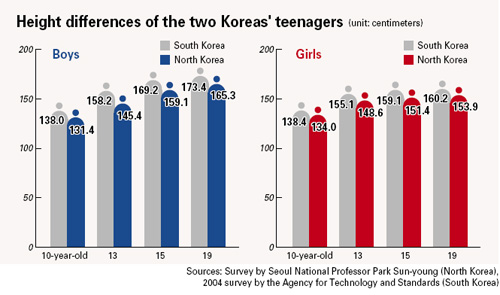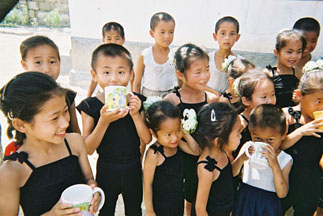Height differences raising eyebrows
Published: 05 Feb. 2007, 09:37

Pak Sun-young, an anthropology professor of Seoul National University, said a 10-year-old North Korean boy is 6.6 centimeters (2.6 inches) shorter than his South Korean counterpart on average, while a 10-year-old North Korean girl is 4.4 centimeters shorter.
She said the height gap tends to get wider for older defectors. She based her research on the body measurements of 1,193 North Korean children and youngsters who entered South Korea between 1999 and April 2006.
Ms. Park said the differences in their physiques could result in discrimination against former North Koreans after a possible unification, and could cause them to feel alienated.
It took two decades for South Korean children to grow by 5.6 centimeters, experts said, adding that the height of North Korean children will reduce even further unless the country opens up soon.
“When pregnant women and infants are malnourished, the physical development of not only themselves but their children and grandchildren are influenced,” said Chang Nam-soo, professor of food and nutritional sciences at Ewha Womans University. “Their stunted physiques will be handed down through generations.”
Experts warned about the dangers faced by babies born to malnourished mothers. Such children are highly likely to suffer from a low immune capability, weakened physical, intellectual and scholastic abilities, a low labor productivity and a higher risk of geriatric diseases, they said.
In mid-January, the JoongAng Ilbo visited an elementary school in Gyeonggi province, where five newly arrived North Korean defectors are studying.
The five 13-year-old boys had fled their communist country three or four months earlier, and came to South Korea almost directly, without spending significant time in China. The average height of the boys was 136.7 centimeters and their weight was 36.7 kilograms (80.9 pounds), far below the average height of 158.2 centimeters and 51 kilograms for the South Korean boys of the same age.
“North Korean defector children seem to be about four or five years younger than their actual age, because of their slow physical development,” said a teacher to one of the boys.

At an elementary school in Wonsan, North Korea, children drink soy milk provided by The First Steps, a Canada-based relief group, at the end of last year. Provided by The First Steps
From 1965 to 1985, when quick industrialization took place in South Korea, the average height of 3-year-old children grew from 89 centimeters to 94.6 centimeters.
According to the United Nations Population Fund, 43 out of 1,000 North Korean infants died within one year after their births last year, 13 times higher than the figure for the South, where the figure was 3 out of 1,000.
In addition to the infant death rate, another UN body also released statistics in 2004 after surveying 4,800 households with children under the age of 7 across North Korea.
Unicef said 37 percent of them suffered from chronic malnourishment.
In the largest ever UN survey on North Korea, more than 32 percent of the 2,109 mothers who had children younger than 2 suffered from malnourishment.
Two of the women weighed less than 45 kilograms. “Inside their bodies, the fetuses developed with malnutrition,” said Kim Dong-soo, professor of medicine at Yonsei University and a pediatrician at Severance Hospital. “Even after the babies are born, their heights are inevitably underdeveloped because they can not receive nutritional breast feeding.”
Experts said the situation could be improved with a support program to provide nutritional foods to pregnant mothers, infants and children and medical goods and as well as an improvement in the country’s health and hygiene systems.
For the unification of Germany, where the height gap was 2 centimeters between East and West Germany,
experts said the international community’s assistance played an important role.
“When we issue sanctions against North Korea, the elite members and the soldiers will survive, but the vulnerable classes will suffer the fatal blow,” said Suh Young-hoon, former head of South Korea’s Red Cross Society. “After unification, those people will be Korean citizens.”
While some groups worry about the possible diversion of aid to fund the Kim Jong-il regime, others highlight the positive side of the assistance programs, particularly the eventual drop in the costs of unification.
“After unification, 90 percent of the 23 million North Koreans will be among the poorest in the welfare system, and that will immediately raise medical insurance budgets by at least 54 trillion won ($57.6 billion) a year,” said Chung Woo-jin, professor of public health at Yonsei University.
He said assisting North Korea’s pregnant women, infants and children to improve their nutritional conditions would largely reduce those costs.
As of now, about 20 relief groups in South Korea are engaged in programs to support North Korean children. Experts and the activists agreed such programs will be beneficial only when they are operated openly, with the ability to follow up on where the aid goes. “It is hard to ask North Korean authorities to cooperate with our monitoring because the project may fall apart,” said an activist from a relief group, on the condition of anonymity.
Yun Hwan-chol, of the Korean Sharing Movement, was more aggressive. “It is now time to present a global standard of relief program to the North and demand the North Koreans meet it,” he said.
By Ser Myo-ja(Staff Writer)/ Special Reporting Team(JoongAng Ilbo) [myoja@joongang.co.kr]










with the Korea JoongAng Daily
To write comments, please log in to one of the accounts.
Standards Board Policy (0/250자)